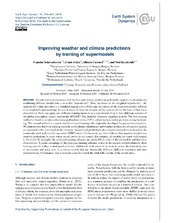| dc.contributor.author | Schevenhoven, Francine Janneke | |
| dc.contributor.author | Selten, Frank | |
| dc.contributor.author | Carrassi, Alberto | |
| dc.contributor.author | Keenlyside, Noel | |
| dc.date.accessioned | 2020-08-10T13:36:31Z | |
| dc.date.available | 2020-08-10T13:36:31Z | |
| dc.date.issued | 2019-11-28 | |
| dc.Published | Schevenhoven FJ, Selten F, Carrassi A, Keenlyside N. Improving weather and climate predictions by training of supermodels. Earth System Dynamics. 2019;10(4):789-807 | eng |
| dc.identifier.issn | 2190-4987 | en_US |
| dc.identifier.issn | 2190-4979 | en_US |
| dc.identifier.uri | https://hdl.handle.net/1956/23627 | |
| dc.description.abstract | Recent studies demonstrate that weather and climate predictions potentially improve by dynamically combining different models into a so-called “supermodel”. Here, we focus on the weighted supermodel – the supermodel's time derivative is a weighted superposition of the time derivatives of the imperfect models, referred to as weighted supermodeling. A crucial step is to train the weights of the supermodel on the basis of historical observations. Here, we apply two different training methods to a supermodel of up to four different versions of the global atmosphere–ocean–land model SPEEDO. The standard version is regarded as truth. The first training method is based on an idea called cross pollination in time (CPT), where models exchange states during the training. The second method is a synchronization-based learning rule, originally developed for parameter estimation. We demonstrate that both training methods yield climate simulations and weather predictions of superior quality as compared to the individual model versions. Supermodel predictions also outperform predictions based on the commonly used multi-model ensemble (MME) mean. Furthermore, we find evidence that negative weights can improve predictions in cases where model errors do not cancel (for instance, all models are warm with respect to the truth). In principle, the proposed training schemes are applicable to state-of-the-art models and historical observations. A prime advantage of the proposed training schemes is that in the present context relatively short training periods suffice to find good solutions. Additional work needs to be done to assess the limitations due to incomplete and noisy data, to combine models that are structurally different (different resolution and state representation, for instance) and to evaluate cases for which the truth falls outside of the model class. | en_US |
| dc.language.iso | eng | eng |
| dc.publisher | Copernicus | en_US |
| dc.rights | Attribution CC BY | eng |
| dc.rights.uri | http://creativecommons.org/licenses/by/4.0/ | eng |
| dc.title | Improving weather and climate predictions by training of supermodels | en_US |
| dc.type | Peer reviewed | |
| dc.type | Journal article | |
| dc.date.updated | 2020-02-10T14:40:14Z | |
| dc.description.version | publishedVersion | en_US |
| dc.rights.holder | Copyright 2019 The Authors | en_US |
| dc.identifier.doi | https://doi.org/10.5194/esd-10-789-2019 | |
| dc.identifier.cristin | 1789009 | |
| dc.source.journal | Earth System Dynamics | |
| dc.relation.project | EC/H2020: 648982 STERCP | |

